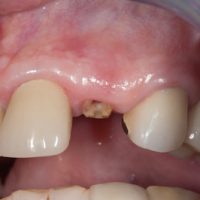A fractured tooth at the gingival margin can be tricky to remove. When the whole tooth is present, extraction forceps can be placed around the crown of the tooth to gently luxate it out of its bony socket. However, when the crown is missing there is usually not enough tooth structure remaining to remove the tooth non surgically. Typically a gingival flap would be elevated and bone would be removed to the extent that forceps could be placed around the tooth root to luxate it. Unfortunately, it is difficult to regain the gingival architecture once surgery is used to remove a tooth. Especially if the tooth will be replaced with a dental implant, preserving the gingival architecture is critical to the cosmetic success of the restoration. The EZ extract tooth removal system can remove tooth roots very atraumatically in these situations. First, the area is anesthetized with a local anesthetic. A drill is used to make a channel inside the root canal system of the tooth. It is slightly smaller in diameter than the pin itself. The pin is then threaded inside the channel. The EZ extraction tool has beaks that engage the head of the pin while using the tray as a fulcrum. The impression material works as a cushion to the adjacent teeth. The dial of the handle is slowly turned, which spreads the beaks of the instrument. This creates upward pressure on the pin, which lifts the tooth gently out of the socket. The procedure to remove the tooth, once the beaks are engaged is only a matter of seconds. Once the pin becomes loose the tray is removed and the tooth comes with it.
As you can see in the case below, all of the gingival architecture was preserved. A bone graft was placed and covered with a collagen membrane. This approach is also conducive to simultaneous dental implant placement and loading. Post operatively, there is minimal discomfort for the patient because of the lack of trauma during extraction.



how do you use the system when there is extensive radicular caries of the coronal 1/3. also there is only one plane of luxation how can this cope with even a slight curvature of root without considerable bone plate and mucosal destruction.
sorry to be cynical but this is just reinventing the wheel, an easy extraction is an easy extraction, one can invent plenty of ways to remove non carious conical straight rooted teeth.
You will be limited by the length of the X-Trac Screws. If the interface to non carious dentin is too deep you will not be able to engage the end of the X-TRACTOR tool, because the head of the screw will be below the plane of occlusion. However if you are able to engage the end of the screw in non carious dentin even though the tooth / pin interface is in caries, you can still get a result. As with any procedure in dentistry case selection is important and of course there are situations where the EZ Extract system would not be appropriate or necessary. I like to use this system for pre-implant extractions where we are trying to preserve as much bone and gingival architeture as possible. It is very useful for teeth which are decayed to the alveolar bone crest that would otherwise require surgical flaps and or bone removal. We have deployed this system in those cases and removed these teeth with no trauma to the surrounding tissues.
Who or where does one purchase this instrument?
Hi Don,
Here is a link EZ Extract System
Please send written instructions for the ez extract system . We have a kit but no instructions .We would appiciated if you could send us the instructions. Thank you
I would contact the manufacturer for that information. I believe the distributor is A-Titan